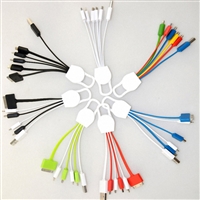
Include VGA (Video Graphics Array), DVI (Digital Visual Interface), HDMI (High Definition Multimedia Interface), USB (Universal Serial Bus), micro USB, mini USB, type B standard USB, and type A standard USB data cable, IDE (Integrated Drive Electronics), SATA (Serial Advanced Technology Attachment), eSATA (External Serial Advanced Technology Attachment), FireWire, Ethernet data cable....
Take a look at any piece of equipment related to computer harder and you'll soon find yourself in a swirling maelstrom of acronyms and foreign jargon. What does it matter if you use IDE or SATA for your hard drive? Do you really need to know the differences between USB 1.0, 2.0, and 3.0? Is FireWire related to Firewall? Sometimes it can get just a bit confusing.
Abbreviations are thrown around in product descriptions without much regard for the user's understanding their meanings. In the end, the responsibility is left to the consumer to learn all of the different types of cables before making a solid decision.
With so many types of cables, however, it's hard to find a singular source of information that highlights the important differences between them all. Here's an overview of the most common computer cable types you'll encounter when dealing with computers.

Created way back in the 1980's, the VGA connection cable was the standard cable used to connect a computer to a monitor. More recently, it has faded out of popularity due to the gradual shift towards digital connections over analog. Still, if you look on any video card or display apparatus, there is a good chance you'll see a VGA port.
VGA connections can be identified by 15 pins arranged in 3 rows with 5 on each row. Each row corresponds to the 3 different color channels used in display: red, green, and blue.

The DVI connection became the successor to VGA as technology moved away from analog towards digital. Digital displays, like LCD, proved to be higher quality, which soon became the market standard for home pictures. DVI connectors come in 3 varieties.

In the past decade, high-definition broadcasts became the new standard of what it means to be high quality. Unlike VGA and DVI, HDMI sends both video and audio signals together. The signals are digital only; thus, HDMI is only compatible with newer devices.
HDMI connectors come in 4 types:

From left to right: micro USB, mini USB, type B standard USB, and type A standard USB (both female and male).
The USB connection is quite possibly the most pervasive connection type in today's world. Nearly every form of computer peripheral device ¡ª keyboards, mice, headsets, flash drives, wireless adapters, etc. ¡ª can be connected to your computer through a USB port. The design has evolved over the years, which means there are multiple versions of USB available:
The mini and micro USB variants are most often used with smaller, portable devices like PDAs, phones, and digital cameras. The standard USB connectors are more often used on devices that tend to remain plugged in, like external hard drives, keyboards, and mice.

IDE cables were used to connect storage devices to a motherboard. If you've ever opened up a an old hard drive then you likely know what an IDE connector looks like. It's the wide cable that looks like a ribbon with more than 2 plugs.
The connectors on an IDE cable have 40 pins; the smaller 2.5" drive variety uses a form-factor version of the IDE that has 44 pins.

Newer hard drives will likely use SATA ports over IDE ports. In fact, SATA was designed to succeed IDE, and it has. Compared to IDE, SATA provides higher data transfer speeds. Your motherboard needs to be compatible with SATA, and nowadays most of them are.
A standard SATA cable can be identified by two connectors, each having 7 pins and an empty notch. It looks like a subtle L-shape.

eSATA technology is an extension of, or improvement on, the SATA cable ¡ª it makes SATA technology available in an external form. In reality, eSATA is not much different from SATA, but it allows connections to devices like external hard drives and optical drives. This is useful because eSATA offers speeds much faster than most FireWire and USB alternatives.

The purpose of FireWire is similar to that of USB: high speed data transfer for computer peripherals. High bandwidth devices, like printers and scanners, will benefit from FireWire. For whatever reason, FireWire is not as widespread as USB. FireWire cables come in two forms: 1394a (which has a transfer speed of 400 Mbps) and 1394b (which has a transfer speed of 800 Mbps).

Ethernet cables are used to set up local area networks. In most cases, they're used to connect routers to modems and computers. If you've ever tried to install or fix a home router, you've likely dealt with an Ethernet computer cable. Nowadays, they come in three varieties:
That should cover it. The cables in this article comprise approximately 99% of all the cables you're likely to find lying around in your home. If there's another cable type that isn't mentioned here, feel free to ask about it in the comments. I'll do my best to answer any questions.
Customer Service
